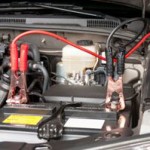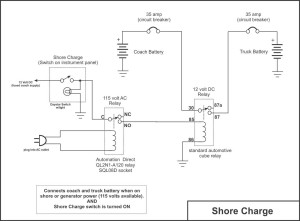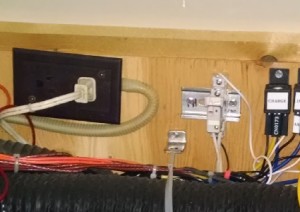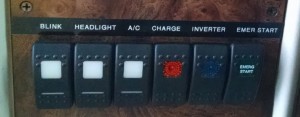 After sitting for about 6 weeks I went to start the truck and was greeted with that click-click-click-click sound as I turned the key. ^@)%<:@&&#$%#*(#@%^
After sitting for about 6 weeks I went to start the truck and was greeted with that click-click-click-click sound as I turned the key. ^@)%<:@&&#$%#*(#@%^
I held in the “EMER START” switch and tried again, the truck started right up.
Its nice to have the EMER START feature, it energizes the Isolator Solenoid and ties the truck and coach batteries together and can save the day when one of the batteries is low or dead
BUT, the problem is, we shouldn’t allow either battery to go dead, this is bad for the battery and will severely shorten its life, especially if its discharged down to zero.
Many of the high end motor coaches tie the truck batter to the coach battery when on shore power or the generator is running, keeping the trucks batteries fresh and charged, I decided to do the same thing.
Attached is the circuit I used to that will automatically tie the coach and truck batteries together,
CIRCUIT DESCRIPTION
When 110 volts is available to the coach, via shore power or the generator, a 110 volt relay energizes, enabling its contacts.
If the Shore Charge switch is ON, current flows thru the switch, thru the energized 110 volt relay contacts, and the cube relay is energized, tying the two batteries together.
CONSIDERATIONS
Isolator – Using an separate cube relay instead of the isolator solenoid – The Isolator relay could have been used for the tie, This would simplify the circuit as all those components exist and are already wired. I chose to use a separate cube relay so as not to keep the isolator solenoid energized for long periods. It also adds a small amount of redundancy.
110 volt relay – Any 110 volt relay will be acceptable, keep in mind it will be energized anytime there is 110 volts on the coach. I used an inexpensive relay and socket available from Automation Direct (to the right of the wall plug). As can be seen in the photo, the relay coil plugs into a standard wall outlet that the TV used to plug into. To the right of the 110 volt relay is the 12 volt cube relay that ties the batteries together.
I could have run the 110 to the shore switch to simplify the circuit, but I decided to keep the 110 volts isolated and away from the 12 volt circuits.
Shore Charge Switch – This is a DayStar switch with an internal amber light indicator. (it looks red in the photo) I wired the indicator to light when the switch is on. I can see this from anywhere in the MH.
NOTE – The Blink, Headlight, and A/C are made by “Carling” . The CHARGE and INVERTER are “DayStar”, the original EMER START is also a “Carling”
Coach Converter – Most early model converters were single stage, i.e., they put out one voltage, period. This voltage was a compromise between running coach loads, charging a battery, but not cooking the battery with to much voltage.
I upgraded my original single stage to a four stage converter from Best Converter. (more on this in another article) This converter has intelligence and adjusts its output to match the conditions it sees, and will not cook a battery (boil fluid due to overcharging)
Battery match – In an ideal world, tying two batteries in parallel is OK, as long as the batteries are matched. Without getting technical, a starting battery and a deep cycle battery are not a good match, so this is not an optimal configuration.
Not optimal, but certainly functional for one start battery and one deep cycle.



